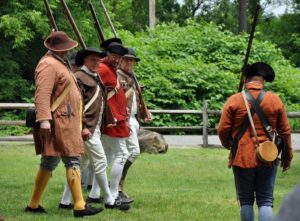Category Archives: Looking Back At History
Soldiers Of The American Revolution March In Pennsauken At Griffith Morgan House
By Robert Fisher-Hughes, AAP Columnist and Amateur Historian
Citizen-soldiers of the Revolutionary War on the march will pause to greet visitors and enlist recruits young and old at historic Griffith Morgan House in Pennsauken on Sunday, Aug. 5 from noon to 4:00 p.m.
Fresh from its recent encampment at the National Constitution Center and the fight at the Battle of Monmouth, the 11th Pennsylvania Regiment of the American Revolution, along with other comrades in arms, return to Pennsauken’s Griffith Morgan House to share their deep knowledge of nation’s founding conflict with visitors. Guests can learn of the sacrifices of the farmers and townspeople who took up arms and can join in the training drills as new recruits themselves. Meanwhile, the ladies supporting the regiment will show how hearty food could be prepared in warm weather months without need of a fire.
Henry W. Longfellow Elementary School And Its Beginnings
 By Robert Fisher-Hughes, AAP Columnist and Amateur Historian
By Robert Fisher-Hughes, AAP Columnist and Amateur Historian
Henry W. Longfellow Elementary School was one of the schools built during the boom years of the 1920s, when the entire Delaware Valley region was rapidly growing, Pennsauken included. Much of this growth was spurred by the expectations aroused by the construction of the first automobile bridge across the Delaware River south of Trenton, then called the Delaware River Bridge and, later, the Benjamin Franklin Bridge. The post-World War years also caused a rapid expansion of business and industry in both Philadelphia and Camden; this in turn generated a rapid growth of population in the nearby suburbs, bringing many new families with children to Pennsauken.
Burrough-Dover House Hosts “Colonial Earth Day” On May 6
By Robert Fisher-Hughes, AAP Columnist and Amateur Historian
This month, wildlife and watersheds, woodcraft, and other matters of the historical environment of Pennsauken and its neighbors are the themes to be explored at the colonial home on the bank of Pennsauken Creek, where the Burrough family first settled in 1710.
The Burrough-Dover House itself is the first image of our ancestral relationship to the natural world: built from natural, local sandstone and timbers felled at the site and still standing more than 300 years later; a true example of sustainability. How many more lessons of environmental significance can we learn in a day by the creek and the woods on the site of the historic colonial farm? Find out at the annual “Colonial Earth Day” event on Sunday, May 6, from noon to 4:00 p.m.
Local Historian Gives Special Presentation At Griffith Morgan House On April 8
By Robert Fisher-Hughes, AAP Columnist and Amateur Historian
On Sunday, April 8, from 1:00 to 4:00 p.m., historic Griffith Morgan House in Pennsauken welcomes local historian Sue Huesken, who will present “Amelia Mott Gummere (1859-1937) – Forgotten Legacy.”
Historic Homes Open For Independence Day Celebration
 Both the Burrough-Dover House, 9201 Burrough-Dover Lane; and Griffith Morgan House, 243 Griffith Morgan Lane off River Rd., will be open to the public for an Independence Day celebration on Sunday, July 2 from 1:00 to 4:00 p.m. What could be more patriotic than a visit to our colonial past?
Both the Burrough-Dover House, 9201 Burrough-Dover Lane; and Griffith Morgan House, 243 Griffith Morgan Lane off River Rd., will be open to the public for an Independence Day celebration on Sunday, July 2 from 1:00 to 4:00 p.m. What could be more patriotic than a visit to our colonial past?
Both houses will be open for free guided tours and the lovely grounds of both sites are perfect for a picnic and outdoor play. Plenty of free parking is available at both houses.
Visit the Griffith Morgan House or Pennsauken Historical Society pages or the group “Pennsauken History Forum” on Facebook for more details or directions; you can also leave a message at (856) 486-9561 or e-mail pennsaukenhistoricalsociety@gmail.com.
Life And Events From 1892 In Pennsauken – Part II
 By Robert Fisher-Hughes, AAP Columnist and Amateur Historian
By Robert Fisher-Hughes, AAP Columnist and Amateur Historian
The creation of Pensauken Township in 1892 was only one way the world was changing in that era.
Looking back on 1892, on the doorstep of the 20th Century, we can see change happening; and from our standpoint a century and a quarter later, we can even see its approach in events that would have been little noticed by the citizens of that era.
Life And Events From 1892 In Pennsauken
 By Robert Fisher-Hughes, AAP Columnist and Amateur Historian
By Robert Fisher-Hughes, AAP Columnist and Amateur Historian
The world in 1892 was different, but people were much the same. Things new then are old now, but they persist in our lives. It was the year the Nutcracker ballet debuted in Tsarist Russia; the rules of the new game of basketball were published; and the character of Sherlock Holmes first appeared as a collection of stories in book form.
A Special Postage Stamp For Labor Day, 1956
 By Robert Fisher-Hughes, AAP Columnist and Amateur Historian
By Robert Fisher-Hughes, AAP Columnist and Amateur Historian
Since the invention of the first postage stamps in the United Kingdom in the 1840, an innovation adopted by the United States since 1847, a veritable gallery of art and history in the form of a practically useful commodity has been available to the public for a few pennies. Nevertheless, only the true enthusiasts, collectors, and scholars of philately, the study of postage stamps, fully appreciate the beauty and value of these tiny scraps of paper.
An example of the art and history embodied in a postage stamp happens to link to an icon of our local history: the three-cent, Labor Day issue of 1956.
Ninety Years Ago: The Sesquicentennial Was Turning Point for Pennsauken
 By Robert Fisher-Hughes, AAP Columnist and Amateur Historian
By Robert Fisher-Hughes, AAP Columnist and Amateur Historian
Sesquicentennial is not a word that comes up in every day conversation. Ninety years ago, however, it was the subject of much discussion and planning, especially in the Philadelphia area.
In July, 1926, the Sesquicentennial celebration was the culmination of such wide ranging plans and development that we may well remember it as a pivotal event, transforming our township and our region, triggering succeeding changes that created the landscape and community of the Pennsauken we know today.
April Marks Ninetieth Anniversary Of Nellie Bly Wreck In Pennsauken
By Robert Fisher-Hughes, AAP Columnist and Amateur Historian
Ninety years ago, the first of two fatal train wrecks occurred near the same curve of track at Derousse Ave. in Delair. While the toll of this earlier accident was much less in terms of loss of life and injury, the response of the community was similar in both tragedies, evoking both shock and horror and a rising to the occasion that we would well remember to this day.


